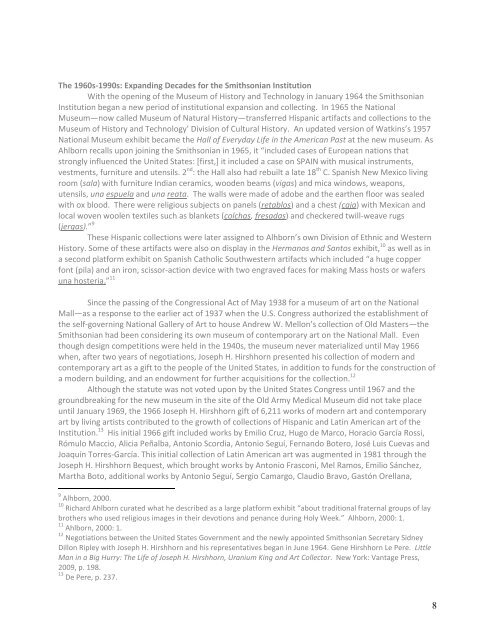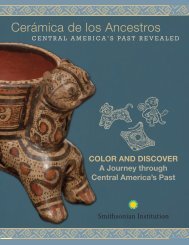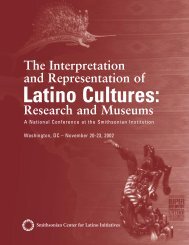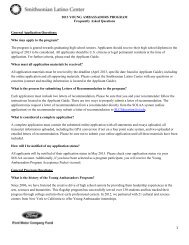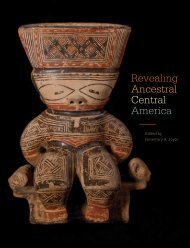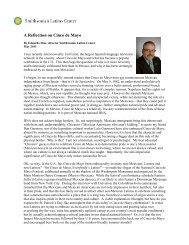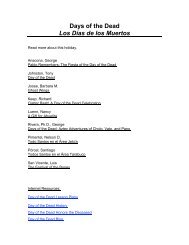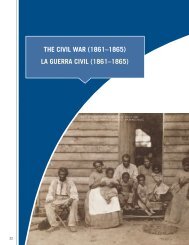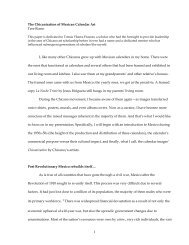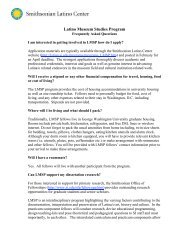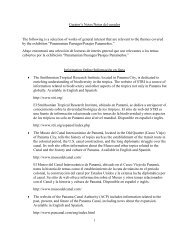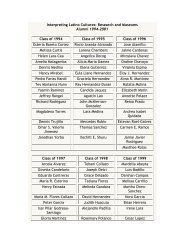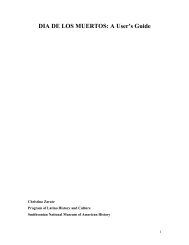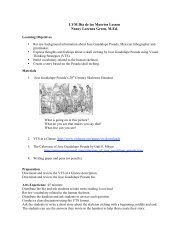smithsonian latino art collections - Smithsonian Latino Center
smithsonian latino art collections - Smithsonian Latino Center
smithsonian latino art collections - Smithsonian Latino Center
You also want an ePaper? Increase the reach of your titles
YUMPU automatically turns print PDFs into web optimized ePapers that Google loves.
The 1960s-1990s: Expanding Decades for the <strong>Smithsonian</strong> Institution<br />
With the opening of the Museum of History and Technology in January 1964 the <strong>Smithsonian</strong><br />
Institution began a new period of institutional expansion and collecting. In 1965 the National<br />
Museum—now called Museum of Natural History—transferred Hispanic <strong>art</strong>ifacts and <strong>collections</strong> to the<br />
Museum of History and Technology’ Division of Cultural History. An updated version of Watkins’s 1957<br />
National Museum exhibit became the Hall of Everyday Life in the American Past at the new museum. As<br />
Ahlborn recalls upon joining the <strong>Smithsonian</strong> in 1965, it “included cases of European nations that<br />
strongly influenced the United States: [first,] it included a case on SPAIN with musical instruments,<br />
vestments, furniture and utensils. 2 nd : the Hall also had rebuilt a late 18 th C. Spanish New Mexico living<br />
room (sala) with furniture Indian ceramics, wooden beams (vigas) and mica windows, weapons,<br />
utensils, una espuela and una reata. The walls were made of adobe and the e<strong>art</strong>hen floor was sealed<br />
with ox blood. There were religious subjects on panels (retablos) and a chest (caja) with Mexican and<br />
local woven woolen textiles such as blankets (colchas, fresadas) and checkered twill-weave rugs<br />
(jergas).” 9<br />
These Hispanic <strong>collections</strong> were later assigned to Alhborn’s own Division of Ethnic and Western<br />
History. Some of these <strong>art</strong>ifacts were also on display in the Hermanos and Santos exhibit, 10 as well as in<br />
a second platform exhibit on Spanish Catholic Southwestern <strong>art</strong>ifacts which included “a huge copper<br />
font (pila) and an iron, scissor-action device with two engraved faces for making Mass hosts or wafers<br />
una hosteria.” 11<br />
Since the passing of the Congressional Act of May 1938 for a museum of <strong>art</strong> on the National<br />
Mall—as a response to the earlier act of 1937 when the U.S. Congress authorized the establishment of<br />
the self-governing National Gallery of Art to house Andrew W. Mellon’s collection of Old Masters—the<br />
<strong>Smithsonian</strong> had been considering its own museum of contemporary <strong>art</strong> on the National Mall. Even<br />
though design competitions were held in the 1940s, the museum never materialized until May 1966<br />
when, after two years of negotiations, Joseph H. Hirshhorn presented his collection of modern and<br />
contemporary <strong>art</strong> as a gift to the people of the United States, in addition to funds for the construction of<br />
a modern building, and an endowment for further acquisitions for the collection. 12<br />
Although the statute was not voted upon by the United States Congress until 1967 and the<br />
groundbreaking for the new museum in the site of the Old Army Medical Museum did not take place<br />
until January 1969, the 1966 Joseph H. Hirshhorn gift of 6,211 works of modern <strong>art</strong> and contemporary<br />
<strong>art</strong> by living <strong>art</strong>ists contributed to the growth of <strong>collections</strong> of Hispanic and Latin American <strong>art</strong> of the<br />
Institution. 13 His initial 1966 gift included works by Emilio Cruz, Hugo de Marco, Horacio García Rossi,<br />
Rómulo Maccio, Alicia Peñalba, Antonio Scordia, Antonio Seguí, Fernando Botero, José Luis Cuevas and<br />
Joaquín Torres-García. This initial collection of Latin American <strong>art</strong> was augmented in 1981 through the<br />
Joseph H. Hirshhorn Bequest, which brought works by Antonio Frasconi, Mel Ramos, Emilio Sánchez,<br />
M<strong>art</strong>ha Boto, additional works by Antonio Seguí, Sergio Camargo, Claudio Bravo, Gastón Orellana,<br />
9 Alhborn, 2000.<br />
10 Richard Ahlborn curated what he described as a large platform exhibit “about traditional fraternal groups of lay<br />
brothers who used religious images in their devotions and penance during Holy Week.” Alhborn, 2000: 1.<br />
11 Ahlborn, 2000: 1.<br />
12 Negotiations between the United States Government and the newly appointed <strong>Smithsonian</strong> Secretary Sidney<br />
Dillon Ripley with Joseph H. Hirshhorn and his representatives began in June 1964. Gene Hirshhorn Le Pere. Little<br />
Man in a Big Hurry: The Life of Joseph H. Hirshhorn, Uranium King and Art Collector. New York: Vantage Press,<br />
2009, p. 198.<br />
13 De Pere, p. 237.<br />
8


